Making homemade herbal medicine is so empowering. For each project I do, by the end all I want is to learn more. I have always wanted to learn how to make a tincture, but figured that it was difficult. As it turns out, it’s actually quite easy! Elderberry and echinacea tinctures are simple to make and perfect for beginning herbalists to start with.
Herbal Academy Course
You may have heard me mention once or twice that I’m taking the online Intermediate Herbal Course at the Herbal Academy.
I took the Intro Herbal Course last year and thought it was great, and I wanted to expand my knowledge more. I’ve learned many cool things this time around, including how to make a tincture!
Elderberry & Echinacea Tincture Recipes
Since cold and flu season is happening whether I want it to or not, I decided to make two different tinctures that I commonly use during this time of year: elderberry and echinacea.
I had a bunch of foraged elderberries that I dried, and I thought this would be the perfect use for them, and echinacea root is an old standby.
This makes two separate tinctures, one elderberry and one echinacea.
The amount of dried herbs and alcohol you use depends on the size jars that you want to use for tincture making. I used pint jars, so approximately one cup of each herb (more or less) and one 750ml bottle of vodka.
What you need
- dried elderberries (can also use fresh elderberries if you have access to them)
- dried echinacea angustifolia root
- 80 proof vodka
- 2 mason jars with lids
How to make the tinctures
Fill your jars ½ – ¾ full with the dried herbs, then completely cover them with the vodka. I had more echinacea root than elderberries, so it will probably end up being a stronger tincture.
Cover tightly with a lid, and gently shake to make sure that all of the dried herbs are saturated. Keep the jars in a cool and dark place for 4-6 weeks.
Check on them from time to time and rock the jar back and forth a bit. Add more alcohol if needed to keep the herbs covered if evaporation has occurred.
After 4-6 weeks the tinctures will be dark in color and ready to strain. Place a piece of cheesecloth in a fine mesh sieve over a bowl or large jar. Pour out the contents of the tinctures.
Squeeze out as much liquid as you can from the cheesecloth. The echinacea in particular holds a lot of liquid in the dried root matter.
That’s pretty much all there is to it, your tinctures are now made!
You can keep them in jars like this and just take a small spoonful at a time when you’re starting to feel under the weather.
This is potent stuff, so don’t go overboard! A little goes a long way. Be sure to label the jars, and it’s a good idea to date them as well.
You can also transfer the tinctures into more traditional dropper bottles using a small funnel, if that suits your fancy. It makes it easier to get the right dose that way as well.
If you prefer to buy tinctures rather than make your own, I highly recommend Herb Pharm! They carry Elderberry Tincture and Echinacea Tincture, as well as different immune boosting blends, alcohol-free glycerites, and products for kids. Use this code for 15% off your order: COLLEEN15
Herb Pharm products can also be found on Amazon here.
Both of these herbs are well known for their immune boosting properties!
Another great way to use elderberries is in this Simple Elderberry Syrup recipe.
Learn more about the healing power of herbs, and great herbal recipes like this from the Herbal Academy!
More Elderberry Recipes
Show your immune system some extra love and discover your favorite way to enjoy elderberries!
What is your favorite herbal remedy during cold and flu season?
Elderberry & Echinacea Tincture
Ingredients
Elderberry Tincture
- 1 cup dried elderberries, (can also use fresh if you have access to them)
- 375 ml 80-proof vodka
Echinacea Tincture
- 1 cup dried echinacea angustifolia root
- 375 ml 80-proof vodka
Instructions
How to Make a Tincture
- Fill your jars 1/2 – 3/4 full with the dried herbs, then completely cover them with the vodka.
- Cover tightly with a lid, and gently shake to make sure that all of the dried herbs are saturated.
- Keep the jars in a cool and dark place for 4-6 weeks. Check on them from time to time and rock the jar back and forth a bit. Add more alcohol if needed to keep the herbs covered if evaporation has occurred.
- After 4-6 weeks the tinctures will be dark in color and ready to strain. Place a piece of cheesecloth in a fine mesh sieve over a bowl or large jar. Pour out the contents of the tinctures.
- Squeeze out as much liquid as you can from the cheesecloth. The echinacea in particular holds a lot of liquid in the dried root matter.
Notes
- Adult Acute Dosage: ¼- ½ teaspoon every hour during illness.
- You can also transfer the tinctures into more traditional dropper bottles using a small funnel, if that suits your fancy. It makes it easier to get the right dose that way as well.
- Shelf Life: Tinctures last for years.



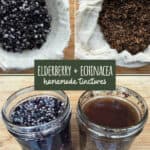

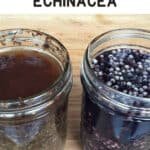

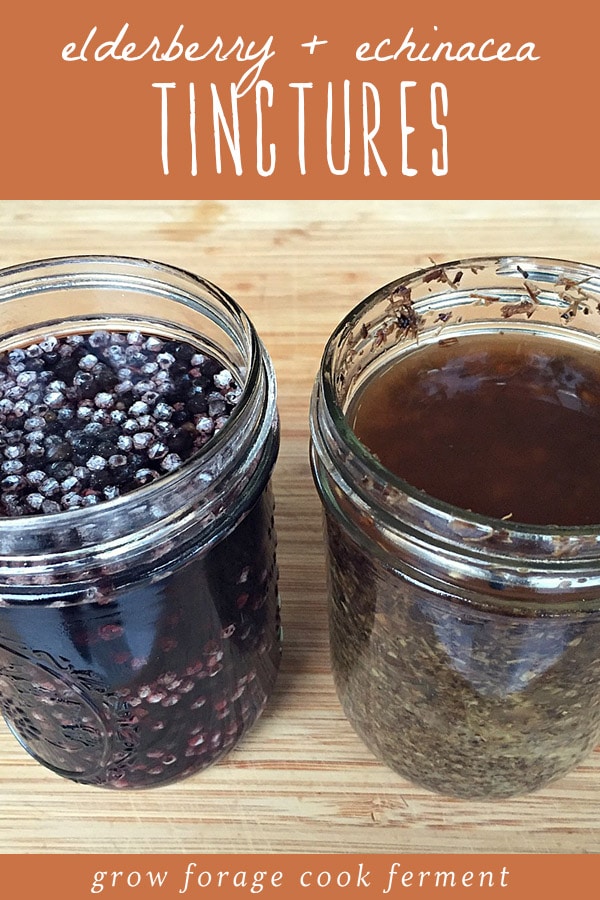


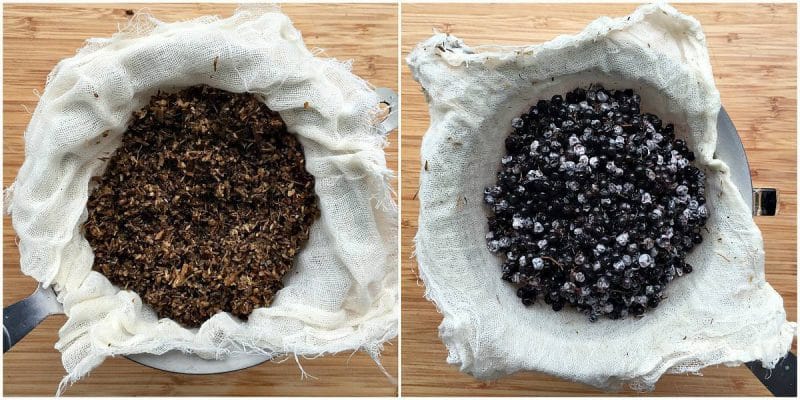
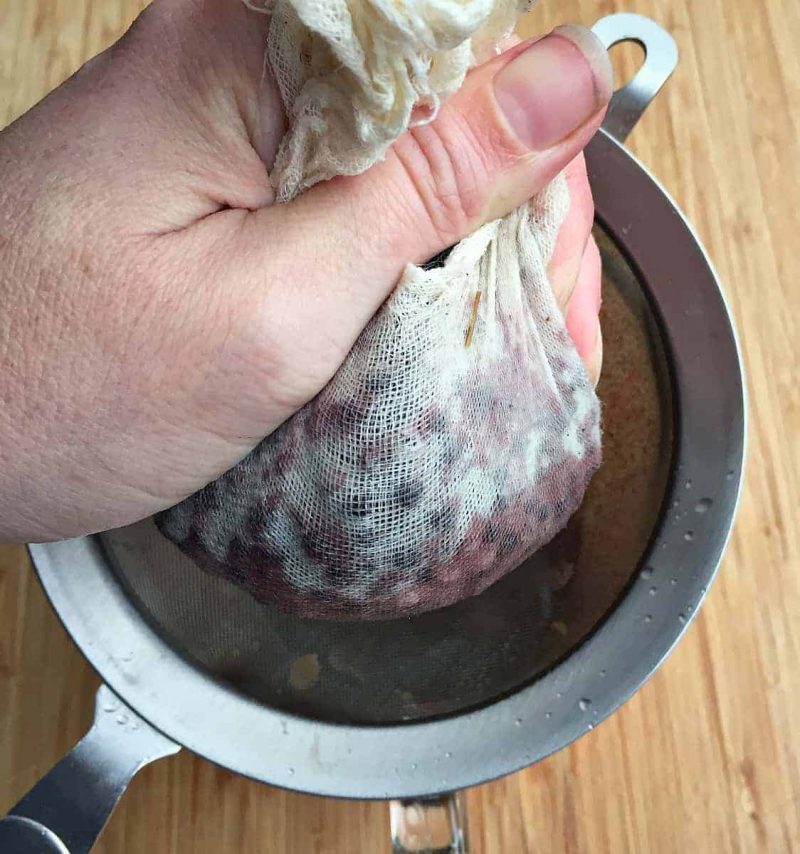

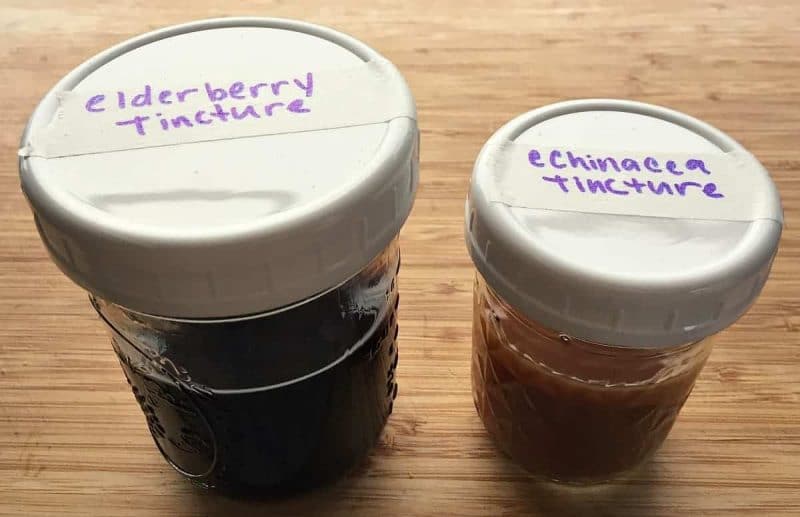


Hi there,
I have generally made the elderberry tincture with fresh berries. Will this recipe work with the fresh berries as well?
Thanks,
Robe
Definitely!
And what about frozen berries, would that be a possibility? I already made juice and syrup, but did not use all the berries I had, so I put them in the freezer.
I’d like to make a tincture as well, but don’t know if this will work with the leftover frozen berries??
Yes, you can use thawed frozen berries to make the tincture.
I’m wondering, I started the elderberry tincture Nov 28. My husband has the flu. Can I use my tincture as long as I strain it to prevent myself from getting the flu from him, and possibly shorten his time laid up? So sorry if this is a dumb question. I tried looking but can’t find anything about what sets the length of soaking except strength. Is weak better than nothing? Or is there another reason for soaking 4 weeks?
Hi, Cheri! It wouldn’t hurt to try it! It may be a weaker dose though.
Thank you!!
Thinking of straining 1/4 cup fir use now. Then add move vodka and let rest continue. Or will that ruin it?
That should work.
Wondering how soon I can use a freshly made tincture. My tincture is only about 3 weeks old. My husband has the flu and I am wondering if its too soon to use it. I really don’t want the flu and would like to help him if possible.
Thanks
Thanks you for a great informative site. I do have a question though… anyone have a recipe for Elderberry Jelly ( not jam) using dehydrated berries?
Thanks for any and all info
Eva
Seems squishing the berries might work better am I wrong.
Can an elderberry tincture be made with tequila?
It can be, but I’m not sure how good that would be. Might make a nice cocktail though!
Made my tincture, bottled it. Forgot it at my mother’s after showing it off. Sent to pick it up at thanksgiving, he just threw it out thinking it would have gone sour. Uhh huh vodka. ….sour. She knows better, she always made tinctures. Said she forgot…sorry. So frustrating cause I used all my elderberry fresh. No more till next summer.
Hi, I’m wondering if you’ve ever made a tincture with the two combined? Is that still effective or advised?
Rich Ceh told me that he uses elderberry glycerites almost exclusively. Apparently it’s quite tasty.
I tend to use alcohol for everything, but this year meant to try the glycerine.
How do you figure out dosing for cold-care vs. how much to take daily? Does size, weight, age, matter?
Do you HAVE to use alcohol?
You can use Raw Apple Cider Vinegar or Food grade vegetable glycerin in place of alcohol. I have celiac so I can’t have most brands of 80 proof vodka since they are made with wheat, but I make tinctures with ACV or glycerin. There are several blogs that I follow that make tinctures without alcohol. I plan on trying these two with glycerin.
Angie, how did your tinctures turn out?
Question: We are taught at our herboalist school that one should not use raw elderberry because of the cyanide compounds that are only distroyed by heating. . What happens with fresh elderberry tincture? is this the same?
Those compounds are only in the leaves, stems, seeds, and unripe berries. As long as ripe berries are used and then strained out, it will be just fine.
Hello
I’ve made dried elderberry tincture for years the same way you have. I keep in dropper bottle and take a dropper every day start in fall thru spring. Mighty protective!!!
What is the shelf life of a tincture?
At least ten years if stored properly.
Are these allergins…I am allergic to to many things like citrus and yeasts…
I saw one tincture method with a bunch of calculations – use strong alcohol then precisely dilute with water…to get 80 proof. I remember thinking at the time, why not just buy 80 proof off of the shelf? I’m sure they had their reasons, but I’m going to take the easy way out here.
I just bought dried elder flower, and in addition to teas I think I’ll tincture some.
To Courtney’s comment, It’s because you need more liquid and less alcohol; you would need too much alcohol to plant matter ratio if you used 80 proof off the shelf, but diluting an alcohol allows the amount of required liquid at the potency that works the recipe’s ratios